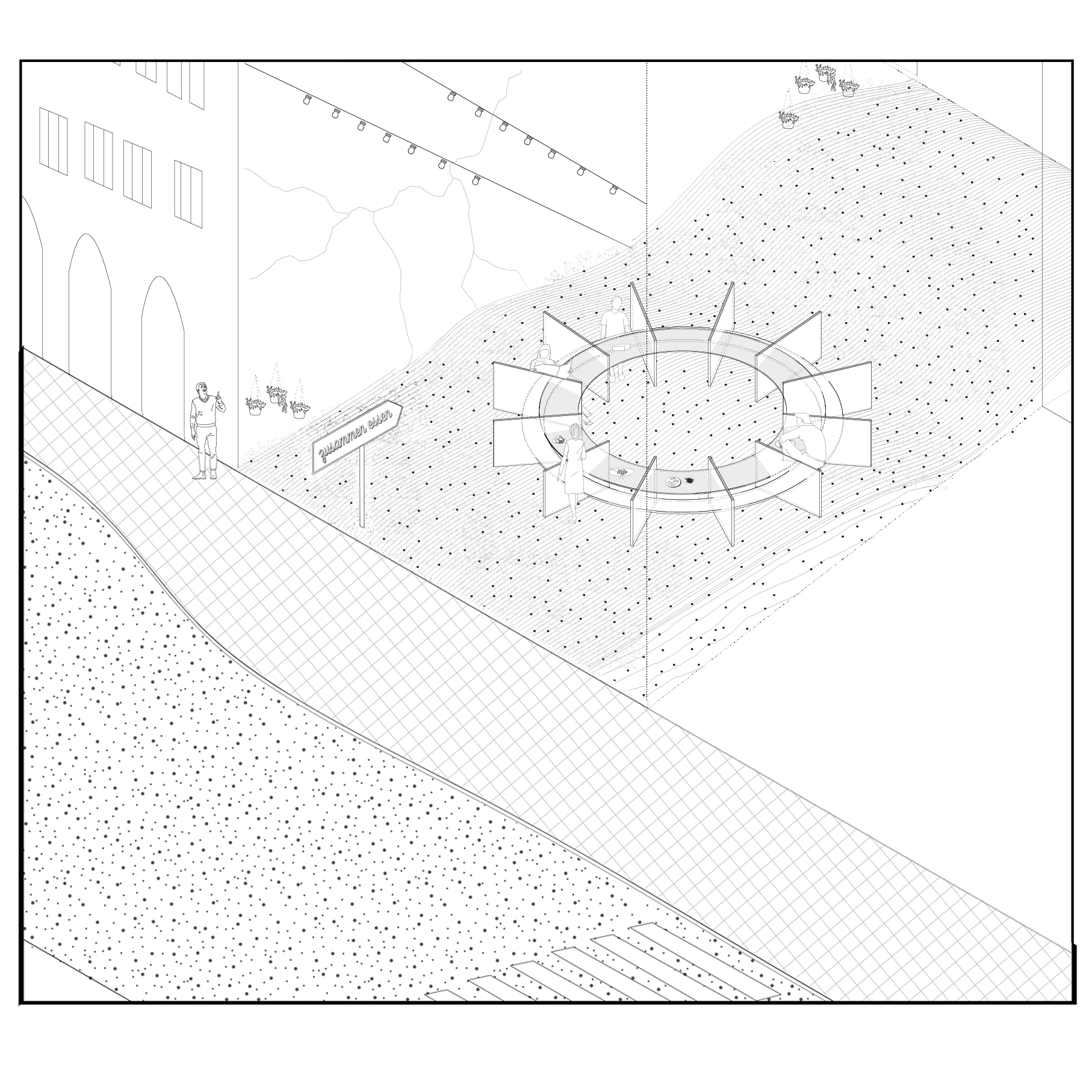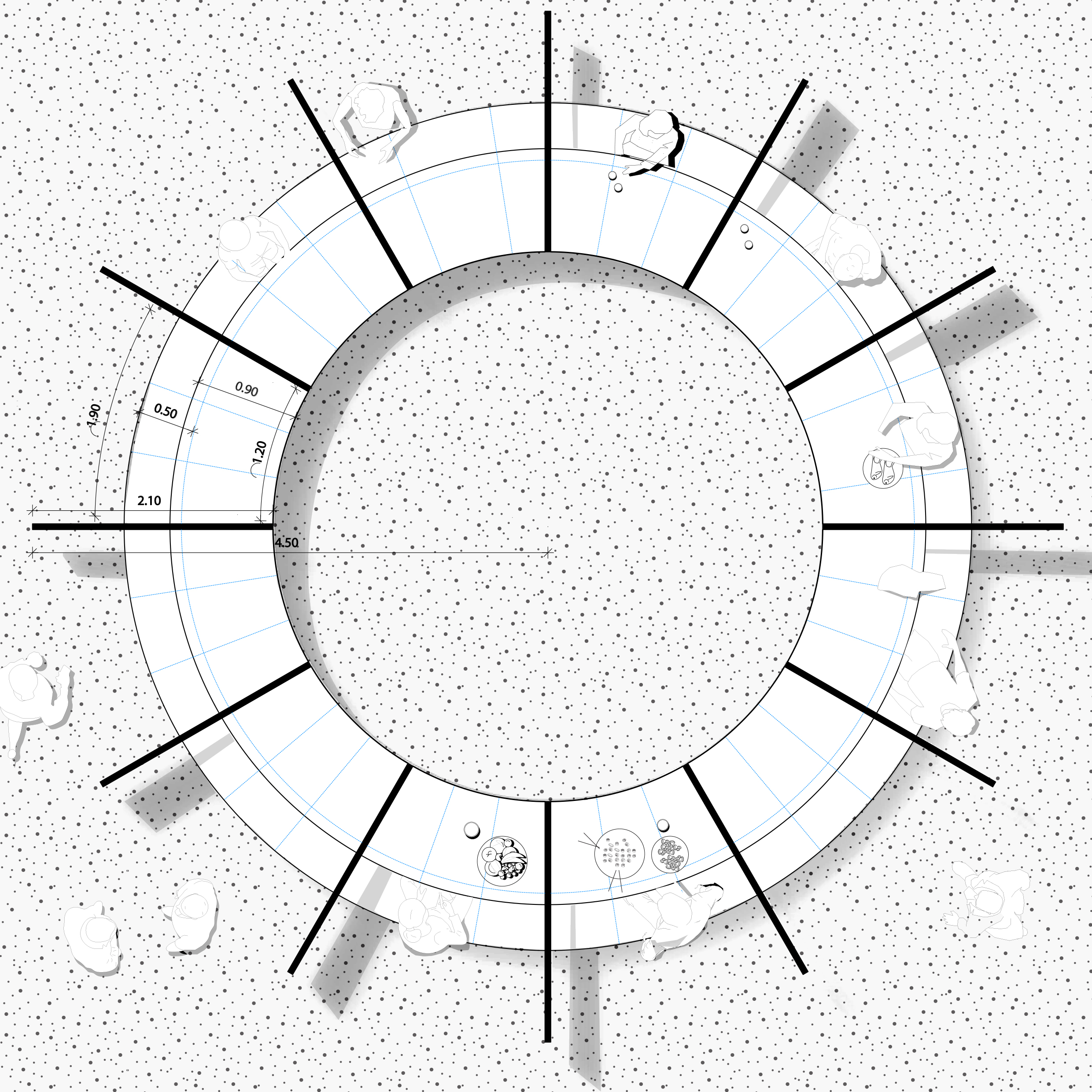Dining Table:
A Memory and a Promise
Type: Open Call for Vienna Design Week 2020
Year: May 2020
Location: Vienna, Austria
Design Team: Eva Lavranou, Chaido Kaproulia
Year: May 2020
Location: Vienna, Austria
Design Team: Eva Lavranou, Chaido Kaproulia
Beyond being a basic survival necessity, food has undoubtedly always been a social practice. Eating transcends the boundaries of an individual activity and becomes a tool for social interaction. People meet at restaurants to enjoy a meal or invite friends over to cook and chat together. A shared meal often acts as a bonding ritual, as it encourages conversations, the exchange of ideas, and the sharing of knowledge or thoughts. After dining with someone, people share a common memory and a sense of intimacy. Moreover, food conveys culture, as different eating practices shape identities and connections within a community. French philosopher Roland Barthes noted, "food is also a system of communication, a body of images, a protocol of usages, situations, and behavior."
The current pandemic has radically altered the way we socialize and communicate. People are spending more time at home, often alone. Cafes and restaurants are either closed or limited to takeaway or delivery services. While people can still go out for walks in parks or the city, the opportunities to socialize and gather have diminished due to social distancing measures. This situation not only affects those looking for places to connect, but also impacts the local economy, as many food-related businesses have been forced to close, which in turn affects producers, consumers, and the wider community.
Public space is a realm of chance encounters, offering opportunities for people to meet strangers. While people rarely invite strangers into their homes, they encounter them on streets, in parks, cafes, and restaurants. These encounters are physical, and bodies carry identities and desires. However, physical proximity is now perceived as a potential threat, leading to increased alienation. In a crisis like this, it is crucial to find ways to maintain public spaces as areas for social interaction and communication, while also ensuring safety. The previous notion that a successful public space was one that was crowded has faded. Design practices must now create safe outdoor environments where beneficial social exchanges can still occur. Vacant urban spaces provide an opportunity for new design ideas, encouraging experimentation and freedom.
What if we transferred a domestic typology into public space? A socially distanced dining area could transform a vacant lot into a public dining room. This proposal suggests that a round public table be placed in vacant spaces in Vienna, creating vibrant communal dining areas. Vertical dividers between each seat ensure social distancing and serve as the table's structural system. The table accommodates 12 seats and is made of a metal structure covered with copper, a material less conducive to virus survival and easy to clean. The circular shape of the table and seating bench eliminates hierarchy, ensuring everyone is equal, and the table is accessible to all members of the community. People can bring their meals, whether homemade or bought from a local restaurant, to support the local economy, and enjoy them alongside other community members or even strangers.
The physical presence of others and the display of food itself become integral parts of this interaction. These vacant spaces can evolve into new urban domestic landscapes, inviting people to enjoy food together and combat social isolation.
The current pandemic has radically altered the way we socialize and communicate. People are spending more time at home, often alone. Cafes and restaurants are either closed or limited to takeaway or delivery services. While people can still go out for walks in parks or the city, the opportunities to socialize and gather have diminished due to social distancing measures. This situation not only affects those looking for places to connect, but also impacts the local economy, as many food-related businesses have been forced to close, which in turn affects producers, consumers, and the wider community.
Public space is a realm of chance encounters, offering opportunities for people to meet strangers. While people rarely invite strangers into their homes, they encounter them on streets, in parks, cafes, and restaurants. These encounters are physical, and bodies carry identities and desires. However, physical proximity is now perceived as a potential threat, leading to increased alienation. In a crisis like this, it is crucial to find ways to maintain public spaces as areas for social interaction and communication, while also ensuring safety. The previous notion that a successful public space was one that was crowded has faded. Design practices must now create safe outdoor environments where beneficial social exchanges can still occur. Vacant urban spaces provide an opportunity for new design ideas, encouraging experimentation and freedom.
What if we transferred a domestic typology into public space? A socially distanced dining area could transform a vacant lot into a public dining room. This proposal suggests that a round public table be placed in vacant spaces in Vienna, creating vibrant communal dining areas. Vertical dividers between each seat ensure social distancing and serve as the table's structural system. The table accommodates 12 seats and is made of a metal structure covered with copper, a material less conducive to virus survival and easy to clean. The circular shape of the table and seating bench eliminates hierarchy, ensuring everyone is equal, and the table is accessible to all members of the community. People can bring their meals, whether homemade or bought from a local restaurant, to support the local economy, and enjoy them alongside other community members or even strangers.
The physical presence of others and the display of food itself become integral parts of this interaction. These vacant spaces can evolve into new urban domestic landscapes, inviting people to enjoy food together and combat social isolation.
Dining Table:
A Memory and a Promise
Τοποθεσία: Βιέννη, Αυστρία
Αρχιτεκτονική Μελέτη: Χάιδω Καπρούλια, Εύα Λαβράνου
Η τρέχουσα πανδημία έχει αλλάξει ριζικά τον τρόπο που κοινωνικοποιούμαστε και επικοινωνούμε. Οι άνθρωποι περνούν περισσότερο χρόνο στα σπίτια τους, συχνά μόνοι. Τα καφέ και τα εστιατόρια είναι είτε κλειστά είτε λειτουργούν μόνο με υπηρεσίες takeaway ή διανομής. Αν και οι άνθρωποι μπορούν ακόμα να βγουν για βόλτες στα πάρκα ή στην πόλη, οι ευκαιρίες για κοινωνικοποίηση και συναντήσεις έχουν μειωθεί λόγω των μέτρων κοινωνικής αποστασιοποίησης. Αυτή η κατάσταση δεν επηρεάζει μόνο όσους αναζητούν μέρη για να συνδεθούν, αλλά έχει επίσης επιπτώσεις στην τοπική οικονομία, καθώς πολλές επιχειρήσεις που σχετίζονται με το φαγητό αναγκάστηκαν να κλείσουν, γεγονός που επηρεάζει τους παραγωγούς, τους καταναλωτές και την ευρύτερη κοινότητα.
Ο δημόσιος χώρος είναι χώρος τυχαίων συναντήσεων, προσφέροντας ευκαιρίες στους ανθρώπους να συναντήσουν αγνώστους. Αν και οι άνθρωποι σπάνια προσκαλούν αγνώστους στα σπίτια τους, τους συναντούν στους δρόμους, στα πάρκα, στα καφέ και στα εστιατόρια. Αυτές οι συναντήσεις είναι φυσικές, και τα σώματα μεταφέρουν ταυτότητες και επιθυμίες. Ωστόσο, η φυσική εγγύτητα σήμερα θεωρείται μια πιθανή απειλή, οδηγώντας σε αυξημένη αποξένωση. Σε μια κρίση όπως αυτή, είναι σημαντικό να βρούμε τρόπους να διατηρήσουμε τους δημόσιους χώρους ως περιοχές κοινωνικής αλληλεπίδρασης και επικοινωνίας, ενώ παράλληλα διασφαλίζουμε την ασφάλεια. Η προηγούμενη αντίληψη ότι ένας επιτυχημένος δημόσιος χώρος ήταν ένας πολυσύχναστος χώρος έχει πλέον ξεθωριάσει. Οι σχεδιαστικές πρακτικές πρέπει τώρα να δημιουργήσουν ασφαλείς υπαίθριους χώρους, όπου μπορούν να πραγματοποιηθούν ωφέλιμες κοινωνικές ανταλλαγές. Οι κενές αστικές εκτάσεις προσφέρουν την ευκαιρία για νέες σχεδιαστικές ιδέες, ενθαρρύνοντας τον πειραματισμό και την ελευθερία.
Τι θα γινόταν αν μεταφέραμε μια οικιακή τυπολογία σε δημόσιο χώρο; Ένας χώρος φαγητού με κοινωνική απόσταση θα μπορούσε να μεταμορφώσει έναν κενό χώρο σε μια δημόσια τραπεζαρία. Αυτή η πρόταση προτείνει ότι ένα στρογγυλό δημόσιο τραπέζι θα τοποθετηθεί σε κενά σημεία στη Βιέννη, δημιουργώντας ζωντανές συλλογικές περιοχές για γεύματα. Κάθε κάθισμα θα χωρίζεται από κάθετους διαχωριστικούς τοίχους, που διασφαλίζουν ότι τηρούνται οι κοινωνικές αποστάσεις και λειτουργούν επίσης ως το δομικό σύστημα του τραπεζιού. Το τραπέζι διαθέτει 12 καθίσματα και είναι κατασκευασμένο από μεταλλική δομή καλυμμένη με χαλκό, ένα υλικό που θεωρείται λιγότερο φιλικό για την επιβίωση του ιού και καθαρίζεται εύκολα. Το κυκλικό σχήμα του τραπεζιού και του καθίσματος έχει επιλεγεί για να εξαλείψει την ιεραρχία. Σε αυτό το τραπέζι, όλοι είναι ίσοι, και το τραπέζι είναι προσβάσιμο σε όλα τα μέλη της κοινότητας. Οι άνθρωποι μπορούν να φέρουν το γεύμα τους, είτε το ετοίμασαν στο σπίτι είτε το αγόρασαν από ένα τοπικό εστιατόριο για να υποστηρίξουν την οικονομία, και να το απολαύσουν μαζί με άλλα μέλη της κοινότητας ή ακόμα και με αγνώστους.
Η φυσική παρουσία άλλων και η παρουσίαση του φαγητού είναι αναπόσπαστα μέρη αυτής της αλληλεπίδρασης. Αυτοί οι κενοί χώροι μπορούν να εξελιχθούν σε νέες αστικές οικιακές τοποθεσίες, προσκαλώντας τους ανθρώπους να απολαύσουν το φαγητό μαζί και να καταπολεμήσουν την κοινωνική απομόνωση.


isola studio
Ippokratous 9, 10679
Athens, Greece
All images produced by isola unless otherwise specified.
Ippokratous 9, 10679
Athens, Greece
All images produced by isola unless otherwise specified.

